- Accueil
- Pages cachées
- Conjuring Mongolian deer stones: biographical statuary of Bronze Age Central Asia and south Siberia
Conjuring Mongolian deer stones: biographical statuary of Bronze Age Central Asia and south Siberia
The enigmatic deer stones speckling the Mongolian steppe have long invited questions. Now fresh research is providing clues to why they were carved and what they may represent. William Fitzhugh and Richard Kortum, with Bayarsaikhan Jamsranjav, share the story of these remarkable relics.
On the treeless Mongolian steppe any vertical apparition catches the eye. It could be a Bactrian camel, a horse-post, or a distant ger, the traditional felt-covered dwelling of the nomad. Or it might just be a fabled deer stone. Singly, or in small arrangements, more than 1,600 of these monoliths stand like silent sentinels watching over the empty expanses. Many others, we reckon, lie fallen and buried. Up to 4.8m tall, these massive standing stones, mostly of granite, were cut, shaped, decorated, and erected during Mongolia’s Late Bronze Age, c.1300-700 BC. They are named for the exaggerated, strikingly stylised maral (Cervus elaphus sibiricus, the Siberian red deer), typically engraved across one or more sides of the rectangular plinths. Until recently, their makers and purposes remained mysteries.
 Only a few deer stones show actual human features and behaviour, among them the remarkable Deer Stone 14 at Uushigiin Uvor in Mongolia. It stands 256cm tall and shows ring ornaments in pierced ears and a modelled human face, whose open mouth suggests an individual engaged in a shamanic song or chant.
Only a few deer stones show actual human features and behaviour, among them the remarkable Deer Stone 14 at Uushigiin Uvor in Mongolia. It stands 256cm tall and shows ring ornaments in pierced ears and a modelled human face, whose open mouth suggests an individual engaged in a shamanic song or chant.
Mongolian deer stones are located mainly between the Gobi Desert in the south and the forested taiga to the north. Outliers exist in southern Russia, eastern Kazakhstan, and Xinjiang, China. A trail of these prehistoric structures extends to the Black Sea and the plains of eastern Europe. First documented in 1892 by archaeologist V V Radlov, deer stones have captivated scores of Soviet/Russian researchers ever since. Some have seen them as ancestors or warriors, others as fertility figures or deities. Still others have interpreted them as shamans or devices for celestial flight. During the 1950s, ’60s, and ’70s, intrepid archaeologist Vitali Volkov criss-crossed the region, recording some 300 deer stones. His 1981 monograph Deer Stones of Mongolia became the bible for all subsequent work.
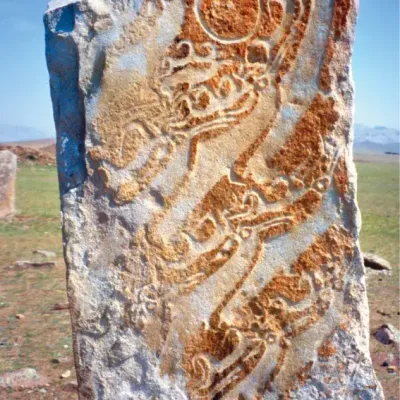 Carvings on the south side of the deer stone known as Uushigiin Uvor DS2 stand out through a thin red haematite-rich layer, and show deer with scrolling Scythian-style antlers packed back-to-belly below an earring. Groundwater salt from centuries of burial has eroded the surface. Some deer stones may have been enhanced by paint.
Carvings on the south side of the deer stone known as Uushigiin Uvor DS2 stand out through a thin red haematite-rich layer, and show deer with scrolling Scythian-style antlers packed back-to-belly below an earring. Groundwater salt from centuries of burial has eroded the surface. Some deer stones may have been enhanced by paint.
Back in 2001, curiosity about possible connections with Old Bering Sea art brought the first author of this article, William Fitzhugh, to Mongolia. Hoping to benefit from new tools such as radiocarbon-dating, laser-scanning, settlement-pattern analysis, and a less artefact-driven excavation strategy, William partnered with Mongolia’s national museum for a new round of studies. Our international teams have included archaeologists, ethnologists, geographers, botanists, biological anthropologists, rock- art specialists, conservators, model-makers, and students. For more than a decade, we retraced Volkov’s footsteps across Mongolia. Happily, our discoveries helped rejuvenate deer-stone research. Among other things, we established the Bronze Age’s formative Deer Stone-Khirigsuur (DSK) Complex as the foundation for later horse-based empires and artistic traditions, such as those found in the renowned Pazyryk and Scythian cultures.
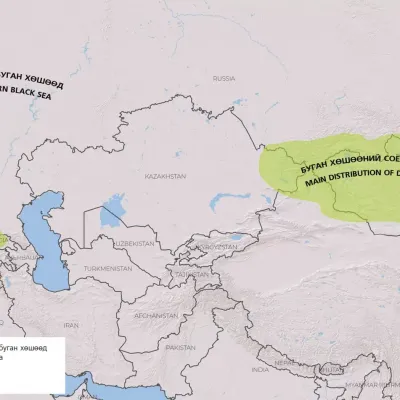 Deer stones are concentrated in the well-watered steppe of northern and western Mongolia, with outliers in Xinjiang, southern Russia, and distant Pontic and Eastern Europe regions.
Deer stones are concentrated in the well-watered steppe of northern and western Mongolia, with outliers in Xinjiang, southern Russia, and distant Pontic and Eastern Europe regions.
Although the COVID-19 pandemic interrupted our fieldwork (2001-2018), our ongoing analyses of location, orientation, and pictorial detail are yielding crucial clues about the life and times of those who left these remarkable monuments. Deer stones are the earliest anthropomorphic statues in Mongolia, pre-dating Turkic ‘stone men’ by more than 18 centuries. These fantastical stones – the Classical type, at least – may document a lineage of 30 generations of nomadic VIPs.
 Deer-stone taxonomy
Deer-stone taxonomy
Deer stones have a rectangular body parsed as head, upper torso, and waist. Arms and legs are never shown. As we interpret them, three (occasionally two) diagonal slashes, always on the head’s eastern side, indicate a face. Circles on either side depict earrings, a string of engraved beads represents a necklace, and a deep groove or band makes for a belt. All deer stones share these features. Volkov classified deer stones into three types, universally referred to today.
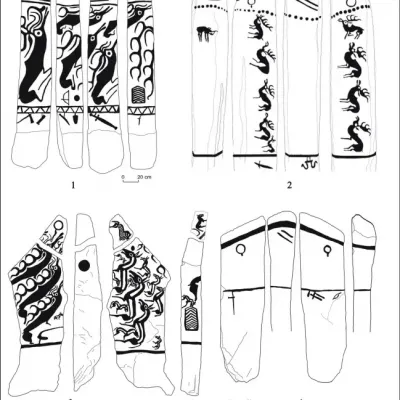 V V Volkov was the first to describe and make a systematic inventory of Mongolian deer stones. His 1961 classification into three types Mongolian-Transbaikal with stylistic deer images, Sayan-Altai with more realistic animal images, and Eurasian with no animal images still adequately describes more than 1,500 known deer stones, but no longer matches his proposed geographic locations. Bayarsaikhan has proposed a fourth type: deer stones with mixed stylised and more realistic animal images.
V V Volkov was the first to describe and make a systematic inventory of Mongolian deer stones. His 1961 classification into three types Mongolian-Transbaikal with stylistic deer images, Sayan-Altai with more realistic animal images, and Eurasian with no animal images still adequately describes more than 1,500 known deer stones, but no longer matches his proposed geographic locations. Bayarsaikhan has proposed a fourth type: deer stones with mixed stylised and more realistic animal images.
Eurasian deer stones: rarely taller than 1m, these are the shortest type. Found from central Mongolia to western Asia, they may, in addition to core features, depict a dagger or tool below the belt. Aside from their relatively diminutive stature, what makes them distinctive is their total lack of animal imagery.
Classic Mongolian (a.k.a. Mongolian-Transbaikal) deer stones: by far the tallest and most elaborate of Volkov’s types, these occur mainly in north-central Mongolia. Next to earring circles they often show a smaller circle, and this pairing is widely interpreted as solar or lunar motifs. Just 13 stones have human faces, but of these only three are fully modelled.
Sayan-Altai deer stones: ranging from 80cm to 1.3m tall, these are found in the vicinity of the Sayan Mountains and the Altai, to the north and west, respectively. On the torso, Saka-style deer with thick, droopy muzzles and standing straight-legged on tiptoes are most often featured; Mongolian deer are normally absent. Depictions of horses, moose, and ibex are common, while pigs, felines, and even fish occasionally appear. Tools ‘float’ above or below the belt.
Torsos prominently display the iconic, elongated maral, usually nested ingeniously one beneath another and wrapped across two or more sides. An upward slant and vestigial legs tucked beneath the body are taken by some to indicate that these deer are shown as if they are flying. Angular heads and a large round eye are typical. The withers peak – that is the highest point of the shoulder – is greatly enlarged, as are wave-like antlers that extend toward the rump. This creature is further characterised by an exceedingly long muzzle, bulbous-tipped and open-mouthed. Like some, the first author – though not the second – sees this as a product of the deer being combined with a bird’s head and beak.
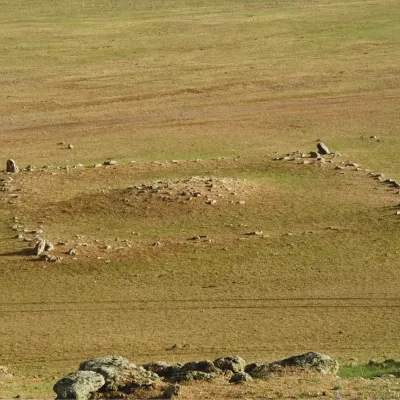 Approximately half of Mongolian khirigsuurs have round fences. The other half have square or slightly trapezoidal fences with upright stones set in small corner mounds containing ritual animal offerings.
Approximately half of Mongolian khirigsuurs have round fences. The other half have square or slightly trapezoidal fences with upright stones set in small corner mounds containing ritual animal offerings.
Often, a disc appears on the stone’s front (east) side, symbolising a shaman’s mirror. Some combination of bows, quivers, axes, swords, knives, daggers, picks, adzes, or chariot rein-hooks hang from the belt. The stone faces east and its west side has a shield-like insignia with chevrons: some have a dozen stripes, others just a few.
Viewed broadly, these stylish, even flamboyant, totems conjure a triple message: of guardian warrior or clan leader, animal-human-spirit transmutation or shamanic clairvoyance, and magical armour.
No less intriguing to Soviet scholars were khirigsuurs found near deer stones. Khirigsuurs are a kind of stone burial-mound surrounded by a ring or square ‘fence’ of half-buried boulders. Mounds can be from 2m to 50m in diameter, and from less than 1m to 10m, or even 20m high. Fences range in diameter from 3m to 400m. Like deer stones, khirigsuurs face east, likely to greet the rising sun. Small mounds – sometimes as many as 1,700 – outside the perimeter’s east side typically cover a horse head, seven neck vertebrae, and four hooves. As with deer stones, these buried heads invariably face east. Beyond the horse mounds, small stone rings (usually of ten stones) contain charcoal and burnt animal bones. We understand these constructions as marking memorial ‘sending-off’ rituals for the honoured individual in the central mound. Herding families who helped build these structures gathered round their hearth-rings to make offerings of sheep, goats, and sometimes larger animals.
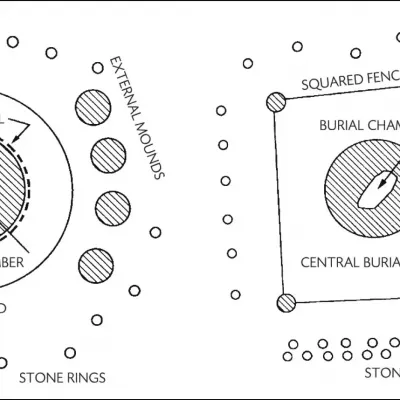 Deer stones are the statuary component of Mongolia’s Late Bronze Age ritual system, which dates c.1400-700 BC. The mortuary component consists of single human interrments in east-facing stone mounds whose sacred inner space is surrounded by a circular or rectangular boulder fence. Outside the fence on the east side are small mounds containing east-facing horse heads, and beyond that lie hearth circles containing the burned remains of domestic animal offerings.
Deer stones are the statuary component of Mongolia’s Late Bronze Age ritual system, which dates c.1400-700 BC. The mortuary component consists of single human interrments in east-facing stone mounds whose sacred inner space is surrounded by a circular or rectangular boulder fence. Outside the fence on the east side are small mounds containing east-facing horse heads, and beyond that lie hearth circles containing the burned remains of domestic animal offerings.
Typically, khirigsuur central mounds covered a single human corpse laid in a shallow depression. Unfortunately, skeletal remains are poorly preserved and bronze or other implements are rarely found. Before our fieldwork, the lack of human remains beneath deer stones led archaeologists to conclude that they and khiriguurs belonged to distinct cultures and time periods. However, freed from a fixation on artefacts, our excavations around the bases of deer stones uncovered small mounds containing identical horse-head bundles and ritual hearth-rings associated with khirigsuurs. We have thus identified these as the core ritual features of Deer Stone-Khirigsuur culture.
Surprisingly, although we never could link any deer stone with a specific khirigsuur in central or northern Mongolia, out west in the Mongolian Altai we found deer stones embedded inside khirigsuur central mounds. Researchers in the Russian Altai have observed the same phenomenon. Radiocarbon-dating provided another surprise. Our excavations produced a consistent chronometry of 1300-700 BC with scant change in the stylised maral or in deer-stone and khirigsuur architecture.
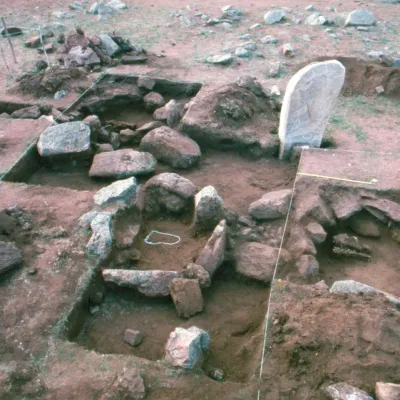 ABOVE & BELOW Ulaan Tolgoi DS4 demonstrated the pattern present at all deer-stone installations: the ritual burial around the stone of east-facing defleshed heads, necks, and hooves of sacrificed horses. These were placed beneath small stone mounds around deer stones and the east side of khirigsuur burial mounds. During the 500-year deer-stone era, hundreds of thousands of horses were sacrificed in this manner. One large khirigsuur at Urt Bulagiin had more than 1,700 horse mounds.
ABOVE & BELOW Ulaan Tolgoi DS4 demonstrated the pattern present at all deer-stone installations: the ritual burial around the stone of east-facing defleshed heads, necks, and hooves of sacrificed horses. These were placed beneath small stone mounds around deer stones and the east side of khirigsuur burial mounds. During the 500-year deer-stone era, hundreds of thousands of horses were sacrificed in this manner. One large khirigsuur at Urt Bulagiin had more than 1,700 horse mounds.
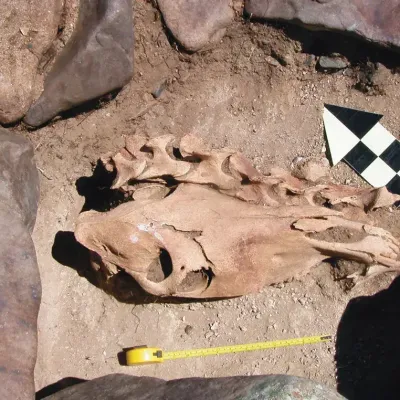 Mongolian Altai
Mongolian Altai
In 2008, reports of deer-stone monuments in western Mongolia led William Fitzhugh to far-western Bayan Ulgii aimag, where he joined forces with rock-art specialist Richard Kortum for an ongoing project (CWA 106). That same summer, during a week-long solo exploration of remote southern Bayan Ulgii, Richard documented 17 new deer stones, the smallest a mere 20.5cm tall. Within that entire province, Volkov had recorded just one.
Deer-stone art
Deer-stone image-making pre-dates the appearance in the region of the representational arts of the Pazyryk culture by some 500 years, and appears 500-1,000 years before the renowned Saka-Scythian ‘Animal-style’ or ‘Early Nomadic’ art. Central themes in deer-stone studies have, unsurprisingly, revolved around the Mongolian deer image. Here, it is important to note that Mongolian deer feature in petroglyphic contexts, too, not just on the deer stones; particularly compelling are those found on slopes or in elevated positions with khirigsuurs situated directly beneath them. Richard has documented instances in both the Altai and northern Mongolia.
So, who or what exactly is this fabulous creature supposed to represent? Why the exaggerated antlers, withers, and snout? Why the apparent hybridisation? And how is it related to other Central Asian motifs? To those who created this enigmatic cervid-form, what did it mean? We now have a basis for an answer.
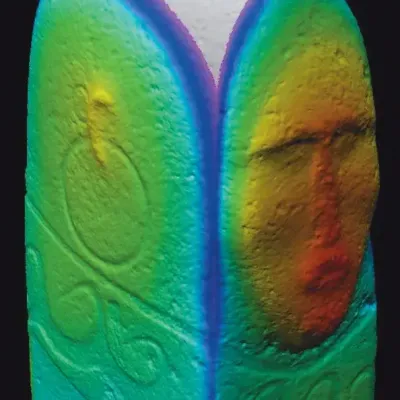 Smithsonian conservators used laser-scanning to record minute details of scores of Mongolian deer stones. This image of Uushigiin Uvor DS14 reveals surface texture and features of the face, ears, necklace, and deer engravings not visible in photographic recording.
Smithsonian conservators used laser-scanning to record minute details of scores of Mongolian deer stones. This image of Uushigiin Uvor DS14 reveals surface texture and features of the face, ears, necklace, and deer engravings not visible in photographic recording.
Deer-stone faces with mouths pursed, as if blowing, whistling, or chanting, are exceptionally rare. Earlier researchers noted the prevalence of shamanic mirrors or drums. A hybrid ‘avian-deer’ branded with shamanic emblems embodies the provisions of a prehistoric cosmology that puts stock in spirits of nature and of animals, their powers, magical transmutability, and cosmic transmigrations. Stone torsos emblazoned with magnificent flying deer echo numerous archaic traditions that forged bodily protections by means of symbolic, or spiritualised, armour, as, for example, by body art and ritualised apparel. That this deer-stone type describes a protective tattoo on a particular warrior or other exalted individual strikes us as eminently plausible.
Deer stones as biography
E A Novgorodova’s meticulous examination of hundreds of deer-stone tools and belt patterns reveals an astonishing variety, with no obvious duplication. This diversity contrasts with a persistent deer imagery whose conventional form was reproduced faithfully for centuries. Such individualisation is a critical indicator of meaning and function. It reveals an intent to replicate paraphernalia identified with specific leaders whose names, personal gear, and idiosyncratic belt designs were widely familiar.
Shield emblems might also denote something significant, like military rank or social status. Further personalisation is conveyed by polished face panels, which probably bore painted likenesses of actual people. The remains of tattooed warriors recovered from frozen Altai tombs (thanks to pioneering work by Sergei Rudenko and Mikhail Griaznov) bolster the idea that deer-stone animal motifs documented tattoos on eminent DSK individuals.
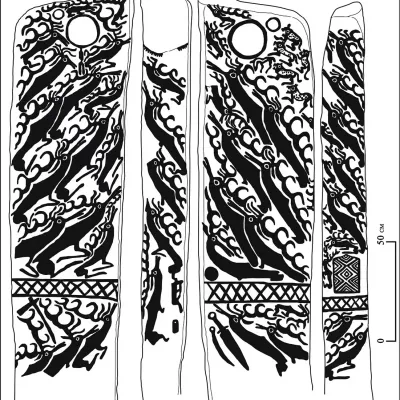 Uushigiin Uvor DS4 displays the power of Mongolia’s Late Bronze Age iconography. Images of the deer-bird figure crowd every surface of this ‘individual’, whose shield, mirror, belt, and weapons are nearly lost in the scrum. Perhaps representing tattoos, this leader was well-protected by ritualised ‘armour’.
Uushigiin Uvor DS4 displays the power of Mongolia’s Late Bronze Age iconography. Images of the deer-bird figure crowd every surface of this ‘individual’, whose shield, mirror, belt, and weapons are nearly lost in the scrum. Perhaps representing tattoos, this leader was well-protected by ritualised ‘armour’.
Now, if deer stones were meant to represent actual people, their settings might, in principle, allow for the reconstruction of specific lineages within DSK communities. Interestingly, multiple deer stones at a single site are installed only a few metres apart in north–south rows. Uushigiin Uvor, for instance, has three such rows: two with six deer stones, and a third with three. Other sites commonly have lines of four to eight stones.
We posit that these settings chronicle a succession of regional luminaries, with parallel rows signifying something like different clan affiliation. If our interpretations are correct, Mongolian deer stones provide a ‘biographical history’ unique to Bronze Age Mongolia.
Reflections
Deer stones appeared with khirigsuurs in southern Russia and north-central Mongolia around 1300 BC. Between 700 and 600 BC, DSK culture in central Mongolia was replaced by a westward-advancing Slab Grave culture; in the Altai, by Pazyryks. Around 600 to 400 BC, Eurasian deer stones appeared in a broad swathe from central Mongolia to southern Russia and the Pontic. A clear picture of deer-stone expansion, however, is currently hampered by a lack of radiocarbon dates and recorded archaeological contexts in western Asia.
 Uushigiin Uvor is the one of the largest deer-stone sites in Mongolia and occupies rich pastures north of the Delger River. Its deer stones stand in three rows, each of which may represent local leadership lineages. The western row has eight stones, each a few metres apart, surrounded by horse-head mounds, and may record a biographical sequence of lineage leaders.
Uushigiin Uvor is the one of the largest deer-stone sites in Mongolia and occupies rich pastures north of the Delger River. Its deer stones stand in three rows, each of which may represent local leadership lineages. The western row has eight stones, each a few metres apart, surrounded by horse-head mounds, and may record a biographical sequence of lineage leaders.
But if our western-migration model is on track, we should expect to find structural differences and more recent dates in Altai khirigsuurs compared with those of central Mongolia. We have, indeed, documented such variability. At western Mongolian deer stones and khirigsuurs, horse sacrifices are virtually unknown, while different architectures (for example, spoked radials and concentric double-ringed fences) are prevalent. Furthermore, western deer stones were frequently erected inside fences, often within the central mound. Such features are entirely foreign to central Mongolia.
Deer stones, similarly, display regional differences. For one, western Mongolia has far fewer Classic types. Second, they are generally made of softer rock, with engravings less finely executed. These distinctions further support a shift of DSK culture from Mongolian heartlands to drier Altai environs.
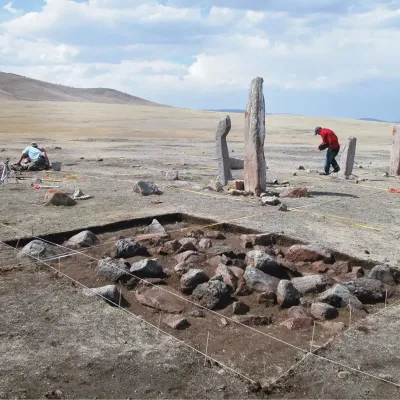 Excavations at Bor Khujiriin revealed seven deer stones placed in north south alignment, with DS4 and DS5 (the largest) in the centre. Most remarkable is the ‘conversation’ between these figures, shown by the face of DS4 bent toward the ear of DS5.
Excavations at Bor Khujiriin revealed seven deer stones placed in north south alignment, with DS4 and DS5 (the largest) in the centre. Most remarkable is the ‘conversation’ between these figures, shown by the face of DS4 bent toward the ear of DS5.
Many have observed that radial lines extending from western khirigsuur mounds to their stone fences resemble spoked chariot wheels. No doubt, this is important. Monacan scholars have recently proposed that sacrificed horses outside the eastern perimeter of khirigsuurs served to conduct the honoured individual into an afterlife. Horse heads found around deer stones must have played a similar role.
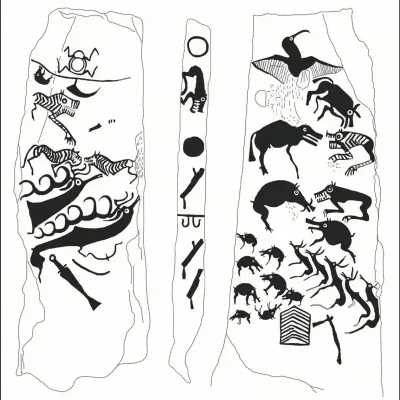
Discovered when a corner of this stone showed above ground, Zuni Gol DS10 turned out to be the Rosetta Stone of Mongolia’s Bronze Age to Iron Age transition. While displaying images of Classic Mongolian deer, it breaks tradition by portraying narrative scenes of animal predation, lacks earrings and face markings, and instead of a symbolic human head has images of a frog on one side and an ibisbill on the other.
Zuni Gol: ramifications and aftermath
In 2015, we unearthed an extraordinary deer stone at Zuni Gol. Its anomalous iconography bears telltale signs of the transition that occurred toward the end of Mongolia’s DSK culture, on the cusp of the Iron Age. The site contains numerous deer stones and khirigsuurs that conform to the standard DSK pattern. This deer stone differs markedly from all others. On one broad face, Deer Stone 10 features a large ibisbill bird with outstretched wings; near the top of the obverse, a frog is prominently pictured. This monolith betrays a distinct lack of emphasis on the Mongolian deer. Moreover, it features neither a belt nor weapons. Its necklace has a boar’s tooth rather than beads. Most astonishing are its predator-prey themes, including a scene of striped felines and a wolf attacking a boar and bovid.
These novel features mark a radical departure from the more formulaic compositions on Classical Mongolian deer stones toward a dynamic, confrontational narrative more in keeping with Pazyryk, Saka-Scythian, and Indo-Iranian norms. Granted, the precise symbolism may forever elude us; notwithstanding, a quiver speaks to a bowman’s prowess, while a mirror augurs shamanic ritual. And the boar’s tooth, frog, ibisbill, tigers, and wolves conjure a new set of spirits for, as examples, guidance, protection, courage, conquest, and longevity, whether in this sphere of life or in other domains or dimensions.
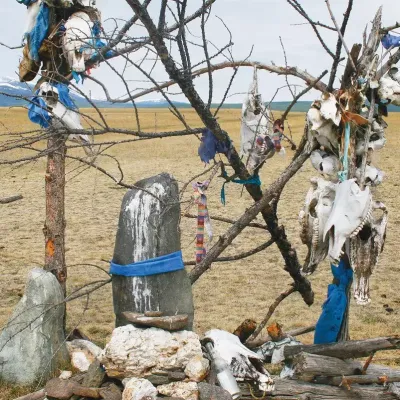 Deer stones continue to play an important role in rural Mongolia, reminding herders of their ancient heritage and serving as ovoos, ‘altars’, for display of combined Buddhist and shamanic belief, seen in these blue silk prayer khadags and horse skulls.
Deer stones continue to play an important role in rural Mongolia, reminding herders of their ancient heritage and serving as ovoos, ‘altars’, for display of combined Buddhist and shamanic belief, seen in these blue silk prayer khadags and horse skulls.
Zuni Gol DS 10 joins attributes of Classical Mongolian and Sayan-Altai deer stones with the more energetic Early Nomadic style, testifying to a transition from the Bronze Age DSK worldview to a new Iron Age outlook. Although we have as-yet no radiocarbon dates for DS 10, nor the atypical khirigsuur nearby, stylistic features signal the close of the deer-stone era, c.600-500 BC.
Epilogue
The search for Asian links to Old Bering Sea art continues. Early Nomadic art and frozen Altai burials point to Old Bering Sea and Ipiutak genomic and cultural connections that date to only a few centuries after Pazyryk. Progress, however, will be difficult until archaeological fieldwork advances in intervening areas of north-eastern Asia.
